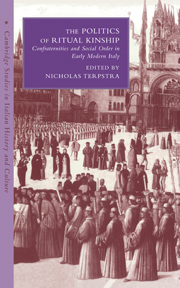Book contents
- Frontmatter
- Contents
- List of Contributors
- Acknowledgments
- Introduction The Politics of Ritual Kinship
- 1 The development of confraternity studies over the past thirty years
- 2 Homosociality and civic (dis)order in late medieval Italian confraternities
- 3 Confraternities and lay female religiosity in late medieval and Renaissance Umbria
- 4 The bounds of community: commune, parish, confraternity, and charity at the dawn of a new era in Cortona
- 5 Men and women in Roman confraternities in the fifteenth and sixteenth centuries: roles, functions, expectations
- 6 The Medici and the youth Confraternity of the Purification of the Virgin, 1434–1506
- 7 In loco parentis: confraternities and abandoned children in Florence and Bologna
- 8 The first Jesuit confraternities and marginalized groups in sixteenth-century Rome
- 9 Jewish confraternal piety in sixteenth-century Ferrara: continuity and change
- 10 The scuole piccole of Venice: formations and transformations
- 11 Relaunching confraternities in the Tridentine era: shaping conscience and Christianizing society in Milan and Lombardy
- 12 The development of Jesuit confraternity activity in the Kingdom of Naples in the sixteenth and seventeenth centuries
- 13 Corpus Domini: ritual metamorphoses and social changes in sixteenth- and seventeenth-century Genoa
- 14 Faith's boundaries: ritual and territory in rural Piedmont in the early modern period
- 15 The suppression of confraternities in Enlightenment Florence
- Bibliography
- Index
- CAMBRIDGE STUDIES IN ITALIAN HISTORY AND CULTURE
6 - The Medici and the youth Confraternity of the Purification of the Virgin, 1434–1506
Published online by Cambridge University Press: 02 October 2009
- Frontmatter
- Contents
- List of Contributors
- Acknowledgments
- Introduction The Politics of Ritual Kinship
- 1 The development of confraternity studies over the past thirty years
- 2 Homosociality and civic (dis)order in late medieval Italian confraternities
- 3 Confraternities and lay female religiosity in late medieval and Renaissance Umbria
- 4 The bounds of community: commune, parish, confraternity, and charity at the dawn of a new era in Cortona
- 5 Men and women in Roman confraternities in the fifteenth and sixteenth centuries: roles, functions, expectations
- 6 The Medici and the youth Confraternity of the Purification of the Virgin, 1434–1506
- 7 In loco parentis: confraternities and abandoned children in Florence and Bologna
- 8 The first Jesuit confraternities and marginalized groups in sixteenth-century Rome
- 9 Jewish confraternal piety in sixteenth-century Ferrara: continuity and change
- 10 The scuole piccole of Venice: formations and transformations
- 11 Relaunching confraternities in the Tridentine era: shaping conscience and Christianizing society in Milan and Lombardy
- 12 The development of Jesuit confraternity activity in the Kingdom of Naples in the sixteenth and seventeenth centuries
- 13 Corpus Domini: ritual metamorphoses and social changes in sixteenth- and seventeenth-century Genoa
- 14 Faith's boundaries: ritual and territory in rural Piedmont in the early modern period
- 15 The suppression of confraternities in Enlightenment Florence
- Bibliography
- Index
- CAMBRIDGE STUDIES IN ITALIAN HISTORY AND CULTURE
Summary
Much has been written on the manipulation of Florentine confraternities and of the whole Florentine confraternal structure by interest groups, families, and individuals since the appearance of the pioneering articles of Rab Hatfield on the Compagnia dei Magi and of Richard Trexler on adolescent confraternities in 1970 and 1974 respectively. Most subsequent studies on Florentine confraternities have broached the subject and have provided valuable if restricted information on it. Notwithstanding their usefulness, we still lack specific analyses of the changes wrought by these manipulations on the internal lives and activities of the affected confraternities. We also do not have a clear understanding of the reasons which prompted such interest groups to seek to control confraternities; nor, finally, are we fully conversant with the means they employed to do so. This paper addresses some of these issues by analyzing the youth confraternity of the Purification of the Virgin both before and after its takeover by the Medici. It concentrates on the first eighty years of the confraternity's life and on two only of its five incarnations.
In the process, it also considers, albeit indirectly, two larger, related issues. These are, first, the nature of patronage; patronage understood as a carefully calculated exchange between patron and client, in this case the Medici and the confraternity of the Purification. Secondly, the reasons for Florence's preoccupation with youths.
- Type
- Chapter
- Information
- The Politics of Ritual KinshipConfraternities and Social Order in Early Modern Italy, pp. 98 - 113Publisher: Cambridge University PressPrint publication year: 1999



